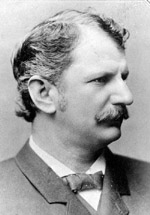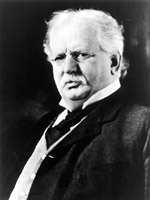Theodore Newton Vail was born in 1847, in Carroll County, Ohio. Vail was a dreamy boy and a great reader and, in his early adulthood, had trouble sticking to any one career. According to Albert Bigelow Paine, in his 1921 biography of Vail, One Man’s Life, “His father more than once declared that he expected to have to support him.”
He went to work for the U.S. Postal Railway System as a mail clerk. From the very beginning on this job, he began to develop the mail delivery system used to this day by the U. S. Postal System. His system allowed mail to be delivered up to two weeks earlier than was done before. He initiated schematic distribution in the West, and within 6 years expanded the system to include the vast network of rails throughout the country. Perhaps the finest tribute to Vail was that his success was met with almost no resentment or jealousy, but rather an outpouring of sincere warmth and congratulations from peers and coworkers. They felt “he faithfully earned the laurels won, and hoped to hear of his continued recognition, believing he belonged further up the scale.”
The American Bell Company
In 1878, Vail became the General Manager of the fledgling Bell Company,
joining the other officers, which consisted of Gardiner Hubbard
(President), Thomas Sanders (Treasurer), Alexander Graham Bell
(Electrician) and Thomas Watson (General Superintendent).
Mergers and buyouts were the order of the day, just as they are currently. Thomas Edison had sold his transmitter (far superior to Bell’s) to Western Union, which had designs on buying the American Bell. However, a young inventor, Francis Blake, Jr., came up with an even better transmitter and sold the http://www.telcomhistory.org/resources/science-of-phones/telephone-patent-follies/”>“Patent Follies” article), Bell bought Western Union and began to offer both telephone and telegraph service. The name of the company was changed to The American Telephone and Telegraph Company, or AT&T.
As technology evolved, copper wire became the conductor of choice, the bell was established as the signaling device and clear, static-free conversations became the norm. Vail himself held a dozen patents.*
 At
age forty, Vail resigned as General Manager of American Bell to become
the first President of AT&T. Theodore Vail had the philosophy that
customer service–not increasing dividends–was the most important thing
to a corporation. His policy and vision was always larger than current
minds. Universal service and commitment to the customer were his
policies. AT&T was almost certainly the first large private
organization to adopt a conscious, clearly articulated policy of
subordinating the maximization of profit to the provision of service, a
milestone in industrial history.
At
age forty, Vail resigned as General Manager of American Bell to become
the first President of AT&T. Theodore Vail had the philosophy that
customer service–not increasing dividends–was the most important thing
to a corporation. His policy and vision was always larger than current
minds. Universal service and commitment to the customer were his
policies. AT&T was almost certainly the first large private
organization to adopt a conscious, clearly articulated policy of
subordinating the maximization of profit to the provision of service, a
milestone in industrial history.
Two years later he resigned from AT&T because of escalating disagreements over service improvements versus short-term financial gain. Vail was unable to convince his Board of the value of “service first.”
Theodore N. Vail Returns
Twenty years later, Vail was asked to return as President. During his
hiatus, he had developed electricity from waterpower in South America,
financed a gold mine in Colorado and invested in electric tramlines.
Vail had left the company in its youth; he now found a great and
wallowing giant, needing to be set on its feet.
During his absence, the company’s directors had viewed their mission as being to milk the Bell Patents for all they were worth until their expiration. The attitude had become one of an elitist monopoly doing the public a favor. When the patents expired and the Bell Company was no longer a monopoly, the trouble really started.
“Independent” companies (those in smaller towns and on farmer’s lines where the Bell company had no service) were now able to compete directly in those areas where Bell had held a monopoly. This ushered in a confusing, chaotic era of two or even three companies in the same area. In order for customers to speak to all others in their own town, it was often necessary to have 2 or three separate telephones and lines. Because of their cavalier attitude, Bell was not always the favorite company among these customers. They were beginning to lose ground. Vail was just the man to help AT&T make the necessary hard decisions and to begin to turn the company around. The first thing they needed was a clear sense of purpose and mission. He set about implementing his strategy to achieve a single communication system offering the best possible service.
 He
put an end to the harassment of the independent telephone companies and
made it attractive for them to link up with Bell. He put new emphasis
on centralized control and standardization of apparatus, equipment and
operating methods. He announced the policy of candor and cooperation
with government regulatory efforts, determined that the telephone system
should remain in private hands. Finally, he established a firm
financial foundation for growth, by raising millions of dollars and
redesigning the AT&T stock offerings to appeal to investors
interested in steady income and growth.
He
put an end to the harassment of the independent telephone companies and
made it attractive for them to link up with Bell. He put new emphasis
on centralized control and standardization of apparatus, equipment and
operating methods. He announced the policy of candor and cooperation
with government regulatory efforts, determined that the telephone system
should remain in private hands. Finally, he established a firm
financial foundation for growth, by raising millions of dollars and
redesigning the AT&T stock offerings to appeal to investors
interested in steady income and growth.
He undertook a vigorous campaign of public relations, and was responsible for the motto, “One policy, one system, and universal service.” He began advertising the story of the Bell System as an institution representative of American life and the American Dream.
In June of 1919, he retired as President and became Chairman of the Board. Vail was 74 years old when he died on April 16, 1920 at Johns Hopkins Hospital in Baltimore. The Vail medal was established in his memory in 1921, to award employees “in recognition of unusual acts or services, which conspicuously illustrate the high ideals which governed the policy of Mr. Vail.” Telecommunications History Group





No comments:
Post a Comment